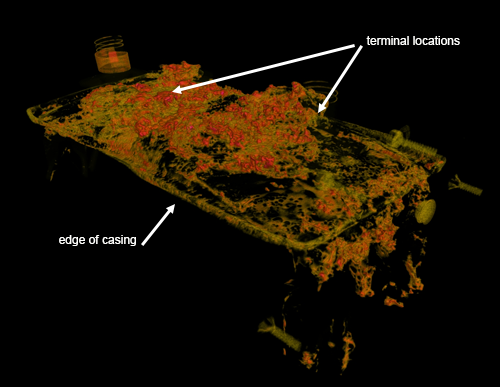
Nine days later, a similar event occurred in-flight on an All Nippon Airways Boeing 787 resulting in an emergency landing in Takamatsu, Japan. That same day, the FAA issued an emergency Airworthiness Directive to address a potential battery fire risk. The entire Boeing 787 fleet was grounded worldwide until an engineering solution was in place (about March 12, 2013).
Earlier this month, the National Transportation Safety Board (NTSB) released its Aircraft Incident Report on the subject, concluding that the fire was probably caused by an internal short circuit within a cell of the lithium-ion battery. To reach that conclusion, the agency relied in part on neutron imaging of the battery cell components conducted at NIST, which convincingly ruled out one alternative explanation.
Two distinct flames had erupted at the electrical connector on the front of the battery case, presumably as the result of heat from a short circuit. But was it an internal or external short? If external, there should be signs that lithium – a good electrical conductor – had escaped the cell and made contact with the cell casing.
The NTSB requested that PML staff scan the battery cell headers with neutron computed tomography (analogous to a medical CT scan, but using neutrons instead of X-rays). Although it is the third lightest element, lithium is a strong neutron absorber, and thus has a distinctive, large, signature in neutron CT.
The CT data, analyzed by NTSB staff, indicated no evidence of external lithium-containing deposits between the cell terminals and the external cell casing. (See figure, top right.) That determination was included as an addendum to the agency report.
The work was conducted at NIST's Neutron Imaging Facility, which is frequently used to examine the composition of materials in fuel cells, batteries, and other devices.

